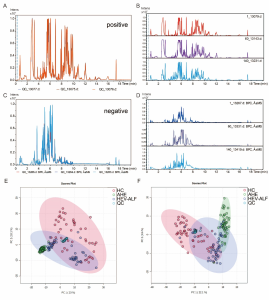In the past decade, acute liver failure (ALF) caused by hepatitis E virus (HEV) infection has become more common, although HEV infection usually causes acute and self-limiting disease. However, there is a lack of biomarkers for identifying disease severity in HEV-related ALF (HEV-ALF). Metabolomics is increasingly being used to map changes in metabolites in different disease states. This essentially contributes to the identification of biomarkers and drug targets. Gas chromatography–mass spectrometry (GC-MS) and liquid chromatography–mass spectrometry (LC-MS) are the main techniques for metabolomics profiling. Attributing to the deep coverage of metabolites and visual analysis, LC-MS metabolomics has been widely used in biomarker research.
A recent study led by Dr. Jian Wu, Prof. Hongcui Cao and Prof. Lanjun Li, from Zhejiang University, China, used ultra-performance liquid chromatography mass spectroscopy (UPLC-MS) to assess serum metabolites in 50 AHE patients, 48 HEV-ALF patients and 49 healthy controls (HC) (Figure). The principal component analysis, partial least squares discriminant analysis, and discriminant analysis of orthogonal projections to latent structures models illustrated significant differences in the metabolite components between AHE patients and HCs, or between HEV-ALF and AHE patients.
The pathway enrichment analysis further identified two altered pathways, including linoleic acid metabolism and phenylalanine, tyrosine and tryptophan biosynthesis, when comparing AHE patients with HCs. Linoleic acid metabolism and porphyrin and chlorophyll metabolism pathways were significantly different in HEV-ALF when compared with AHE patients. The discriminative performances of differential metabolites showed that taurocholic acid, glycocholic acid, glycochenodeoxycholate-3-sulfate, and docosahexaenoic acid could be used to distinguish HEV-ALF from AHE patients. The serum levels of glycocholic acid, taurocholic acid, deoxycholic acid glycine conjugate, and docosahexaenoic acid were associated with prognosis of HEV-ALF patients.
The dynamic changes in serum metabolites were associated with AHE infection and severity. The identified changes in serum metabolite levels can be used to diagnose and predict the prognosis of HEV-ALF, which may provide new clues for the development of new biomarkers and treatment strategies for HEV-ALF.

Figure: Metabolomic profiling by UPLC–MS. Ultra performance liquid chromatography mass spectroscopy (UPLC–MS) total ion chromatograms (TIC) chromatogram generated by three injections in (A) positive ion spectrum (ES+) mode and (C) negative ion spectrum (ES−) mode. Three groups of representative base peak chromatogram (BPC) were obtained in (B) ES+ mode and (D) ES− mode. Unsupervised principal component analysis (PCA) score plots in positive (E) and negative (F) ion mode. The QC samples (blue) showed tight clusters, indicating that the UPLC-MS method existed high stability and repeatability.
Read the full article published in Journal of Medical Virology (2022 Jun;94(6):2714-2726.) https://onlinelibrary.wiley.com/doi/10.1002/jmv.27669

